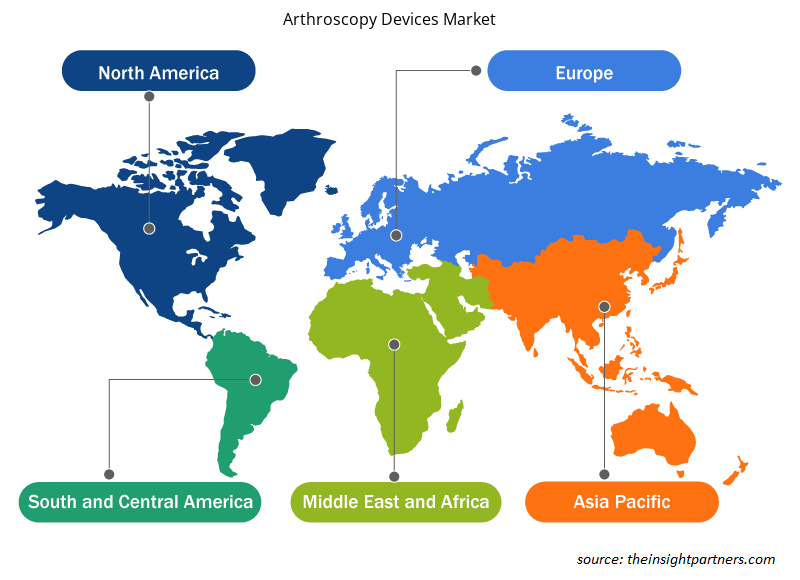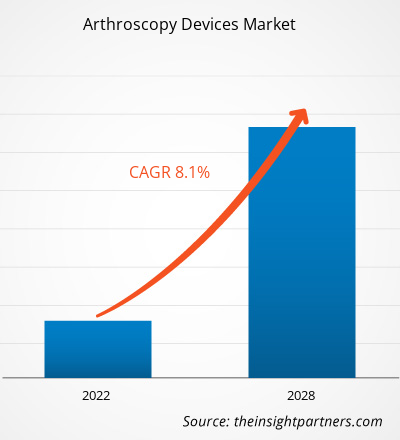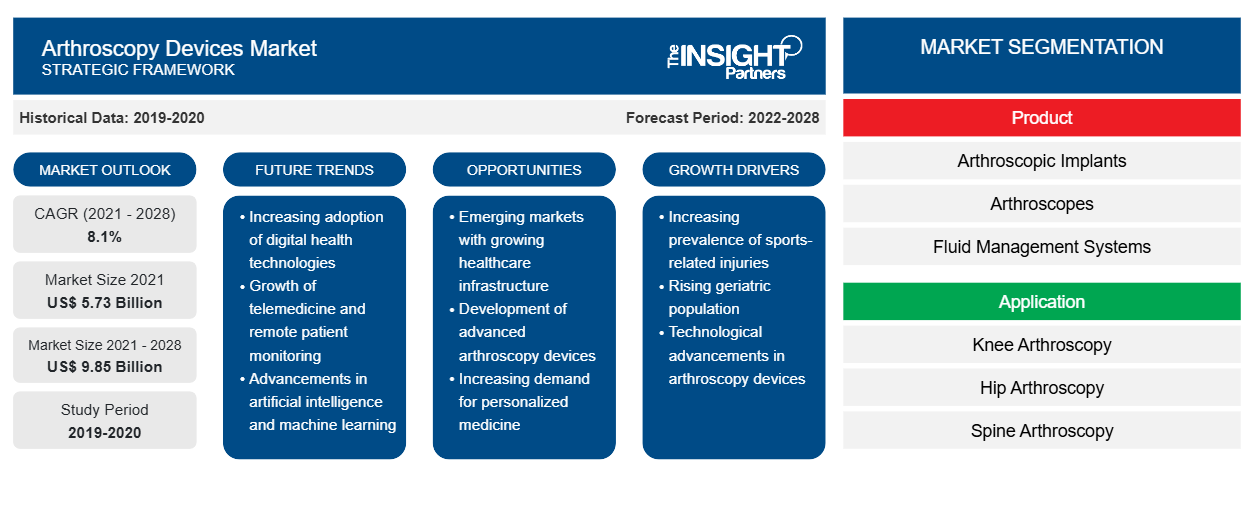Si prevede che il mercato dei dispositivi per artroscopia raggiungerà i 9.853,88 milioni di dollari entro il 2028, rispetto ai 5.725,24 milioni di dollari del 2021; si prevede che registrerà un CAGR dell'8,1% dal 2021 al 2028.
L'artroscopia è una procedura per la diagnosi e il trattamento di problemi articolari. Un chirurgo inserisce un tubo stretto collegato a una telecamera video a fibre ottiche chiamata artroscopio attraverso una piccola incisione delle dimensioni di un'asola. Un artroscopio è un dispositivo medico che consente ai medici di vedere all'interno delle articolazioni del corpo come ginocchio, anca, colonna vertebrale, spalla e gomito per ispezionare, diagnosticare ed eseguire procedure terapeutiche. I dispositivi di artroscopia possono esaminare malattie come osteoartrite, artrite reumatoide, tendinite e tumori ossei nelle articolazioni.
Il rapporto offre approfondimenti e analisi approfondite del mercato dei dispositivi per artroscopia, sottolineando vari parametri come tendenze di mercato, progressi tecnologici e dinamiche di mercato. Fornisce inoltre l'analisi del panorama competitivo dei principali attori del mercato in tutto il mondo. Inoltre, include l'impatto della pandemia di COVID-19 sul mercato in tutte le regioni. La pandemia di COVID-19 ha creato sia una crisi di salute pubblica che una crisi economica in tutto il mondo. Prima della pandemia, il mercato globale dei dispositivi per artroscopia era in costante crescita poiché erano in corso screening, consolazioni e trattamenti regolari. La prima ondata di COVID-19 ha interrotto le consultazioni, i follow-up e gli screening dei casi oncologici. La situazione incontrollata creata nel settore sanitario in tutto il mondo ha portato alla riduzione del numero di consultazioni e a un numero inferiore di casi di osteoartrite e artrite reumatoide diagnosticati. Diverse aziende hanno subito gravi perdite nell'ultimo trimestre del 2019; la pandemia ha influenzato negativamente anche il primo e il secondo trimestre del 2020. Quindi, l'impatto della pandemia di COVID-19 sul mercato globale è stato immediato e drastico. Le aziende in tutto il mondo sono state ostacolate a causa dell'interruzione della catena di fornitura e dell'aumento della domanda di prodotti e servizi sanitari. Per ridurre l'infezione da COVID-19 negli ospedali e nelle cliniche, gli operatori sanitari e i pazienti hanno adottato e preferito il trattamento dei pazienti a distanza. In queste circostanze imprevedibili, la pratica ortopedica non poteva rimanere inalterata. Molti trattamenti chirurgici e visite non urgenti sono stati annullati o posticipati. La chirurgia elettiva è stata sospesa in molte istituzioni e il volume complessivo dei casi ortopedici è diminuito drasticamente per limitare la diffusione del virus e riservare e riallocare le risorse nel personale sanitario (infermieri, anestesisti), nelle attrezzature mediche (dispositivi di protezione individuale, ventilatori) e nei letti. La strategia "resta a casa" nel mondo ha portato a una significativa riduzione degli interventi di artroplastica e artroscopia, nonché a una diminuzione dell'incidenza dei casi di osteoartrite durante il periodo del COVID-19.
Personalizza questo report in base alle tue esigenze
Riceverai la personalizzazione gratuita di qualsiasi report, comprese parti di questo report, o analisi a livello nazionale, pacchetto dati Excel, oltre a usufruire di grandi offerte e sconti per start-up e università
- Scopri le principali tendenze di mercato in questo rapporto.Questo campione GRATUITO includerà analisi di dati che spaziano dalle tendenze di mercato alle stime e alle previsioni.
Poiché l'infrastruttura sanitaria è stata interrotta a causa dell'epidemia di COVID-19 e l'attenzione è stata spostata sul trattamento del COVID-19, la diagnosi di varie malattie è stata trascurata. Inoltre, anche l'individuazione e il trattamento delle malattie muscoloscheletriche sono stati ostacolati dalla pandemia di COVID-19. Ciò ha notevolmente frenato la crescita del mercato dei dispositivi per artroscopia in tutto il mondo.
Approfondimenti di mercato
La crescente prevalenza di disturbi muscoloscheletrici guiderà il mercato
I disturbi muscoloscheletrici (DMS) sono le condizioni di salute più comuni al mondo. Secondo i dati pubblicati dall'Organizzazione Mondiale della Sanità (OMS), a febbraio 2021, circa 1,71 miliardi di individui in tutto il mondo soffrivano di problemi muscoloscheletrici. Il dolore lombare è una condizione muscoloscheletrica diffusa, che colpisce 568 milioni di persone in tutto il mondo. Il dolore lombare è la principale causa di disabilità in 160 paesi. I disturbi muscoloscheletrici compromettono gravemente la mobilità e la destrezza, con conseguente pensionamento anticipato dal lavoro, diminuzione del benessere e ridotta capacità di socializzare. Il numero di persone disabili a causa di condizioni muscoloscheletriche è in crescita e si prevede che questa tendenza continuerà nei prossimi decenni.MSDs) are the most common health conditions worldwide. According to the data published by the World Health Organization (WHO), in February 2021, approximately 1.71 billion individuals worldwide suffered from musculoskeletal problems. Lower back pain is a widespread musculoskeletal condition, affecting 568 million people worldwide. Lower back pain is the major cause of impairment in 160 countries. Musculoskeletal disorders severely impair mobility and dexterity, resulting in early retirement from work, decreased well-being, and diminished ability to socialize. The number of people disabled by musculoskeletal conditions has been growing, and this trend is expected to continue in the next decades.
Inoltre, secondo l'OMS, i paesi ad alto reddito sono i più colpiti in termini di popolazione (441 milioni), seguiti dai paesi della regione del Pacifico occidentale dell'OMS con 427 milioni, mentre il Sud-est asiatico ne ha 369 milioni. Le malattie muscoloscheletriche sono anche la causa principale di anni vissuti con disabilità (YLD) in tutto il mondo, rappresentando circa 149 milioni di YLD, ovvero il 17% di tutti gli YLD. Le fratture, che colpiscono 436 milioni di persone in tutto il mondo, l'osteoartrite (343 milioni), altre lesioni (305 milioni), i dolori al collo (222 milioni), le amputazioni (175 milioni) e l'artrite reumatoide (14 milioni) contribuiscono tutte al peso complessivo delle malattie muscoloscheletriche.YLDs) worldwide, accounting for roughly 149 million YLDs, or 17% of all YLDs. Fractures, which affect 436 million people worldwide, osteoarthritis (343 million), other injuries (305 million), neck pains (222 million), amputations (175 million), and rheumatoid arthritis (14 million) all contribute to the overall burden of musculoskeletal diseases.
L'artroscopia chirurgica è un'opzione terapeutica consolidata per gli individui con dolore e disfunzione articolare cronici. Rispetto alle procedure articolari aperte, l'artroscopia è meno invasiva e comporta migliori risultati complessivi per i pazienti nel trattamento dei sintomi, degenza ospedaliera, recupero strutturale e risultati a lungo termine. Pertanto, si prevede che la crescente prevalenza di disturbi muscoloscheletrici, osteoartrite e artrite reumatoide guiderà il mercato durante il periodo di previsione.
Approfondimenti basati sui prodotti
In base al prodotto, il mercato dei dispositivi per artroscopia è segmentato in artroscopi, impianti artroscopici, sistemi di gestione dei fluidi , sistemi a radiofrequenza, sistemi di visualizzazione, sistemi di rasoio motorizzati e altre apparecchiature artroscopiche. Nel 2021, il segmento degli artroscopi ha detenuto la quota maggiore del mercato e si prevede che registrerà il CAGR più rapido del 9,1% durante il periodo di previsione. radiofrequency systems, visualization systems, powered shaver systems, and other arthroscopic equipment. In 2021, the arthroscopes segment held the largest share of the market and is expected to register the fastest CAGR of 9.1% during the forecast period.
Approfondimenti basati sulle applicazioni
In base all'applicazione, il mercato dei dispositivi per artroscopia è segmentato in artroscopia del ginocchio, artroscopia dell'anca, artroscopia della colonna vertebrale, artroscopia del piede e della caviglia, artroscopia della spalla e del gomito e altri. Nel 2021, il segmento dell'artroscopia dell'anca ha detenuto la quota maggiore del mercato e si prevede che registrerà il CAGR più elevato dell'8,9% nel periodo 2021-2028.CAGR of 8.9% during 2021–2028.
Gli operatori del mercato dei dispositivi per artroscopia adottano strategie organiche, come il lancio e l'espansione dei prodotti, per espandere la propria presenza e il portafoglio prodotti in tutto il mondo e soddisfare la crescente domanda.
Per Geografia
In base all'area geografica, il mercato dei dispositivi per artroscopia è segmentato in Nord America (Stati Uniti, Canada e Messico), Europa (Regno Unito, Germania, Francia, Italia, Spagna e resto d'Europa), Asia Pacifico (Cina, Giappone, India, Australia, Corea del Sud e resto dell'Asia Pacifico), Medio Oriente e Africa (Emirati Arabi Uniti, Arabia Saudita, Sudafrica e resto del Medio Oriente e dell'Africa) e Sud e Centro America (Brasile, Argentina e resto del Sud e Centro America).UAE, Saudi Arabia, South Africa, and the Rest of Middle East & Africa), and South & Central America (Brazil, Argentina, and the Rest of South & Central America).
Approfondimenti regionali sul mercato dei dispositivi per artroscopia
Le tendenze regionali e i fattori che influenzano il mercato dei dispositivi per artroscopia durante il periodo di previsione sono stati ampiamente spiegati dagli analisti di Insight Partners. Questa sezione discute anche i segmenti e la geografia del mercato dei dispositivi per artroscopia in Nord America, Europa, Asia Pacifico, Medio Oriente e Africa e Sud e Centro America.

- Ottieni i dati specifici regionali per il mercato dei dispositivi di artroscopia
Ambito del rapporto di mercato sui dispositivi di artroscopia
| Attributo del report | Dettagli |
|---|---|
| Dimensioni del mercato nel 2021 | 5,73 miliardi di dollari USA |
| Dimensioni del mercato entro il 2028 | 9,85 miliardi di dollari USA |
| CAGR globale (2021 - 2028) | 8,1% |
| Dati storici | 2019-2020 |
| Periodo di previsione | 2022-2028 |
| Segmenti coperti | Per Prodotto
|
| Regioni e Paesi coperti | America del Nord
|
| Leader di mercato e profili aziendali chiave |
|
Densità degli attori del mercato dei dispositivi di artroscopia: comprendere il suo impatto sulle dinamiche aziendali
Il mercato dei dispositivi per artroscopia sta crescendo rapidamente, spinto dalla crescente domanda degli utenti finali dovuta a fattori quali l'evoluzione delle preferenze dei consumatori, i progressi tecnologici e una maggiore consapevolezza dei vantaggi del prodotto. Con l'aumento della domanda, le aziende stanno ampliando le loro offerte, innovando per soddisfare le esigenze dei consumatori e capitalizzando sulle tendenze emergenti, il che alimenta ulteriormente la crescita del mercato.
La densità degli operatori di mercato si riferisce alla distribuzione di aziende o società che operano in un particolare mercato o settore. Indica quanti concorrenti (operatori di mercato) sono presenti in un dato spazio di mercato in relazione alle sue dimensioni o al valore di mercato totale.
Le principali aziende che operano nel mercato dei dispositivi per artroscopia sono:
- Azienda
- Società CONMED
- Johnson and Johnson Services, Inc.
- KARL STORZ SE & Co. KG
- Medtronic
Disclaimer : le aziende elencate sopra non sono classificate secondo un ordine particolare.

- Ottieni una panoramica dei principali attori del mercato dei dispositivi per artroscopia
Profili aziendali
- Azienda
- Società CONMED
- Johnson and Johnson Services, Inc.
- KARL STORZ SE & Co. KG
- Medtronic
- Azienda: Richard Wolf GmbH.
- Fabbro e nipote
- Società per azioni Stryker
- Zimmer Biomet
- NuVasive, Inc.
- Analisi storica (2 anni), anno base, previsione (7 anni) con CAGR
- Analisi PEST e SWOT
- Valore/volume delle dimensioni del mercato - Globale, Regionale, Nazionale
- Industria e panorama competitivo
- Set di dati Excel
Report recenti
Testimonianze
Motivo dell'acquisto
- Processo decisionale informato
- Comprensione delle dinamiche di mercato
- Analisi competitiva
- Analisi dei clienti
- Previsioni di mercato
- Mitigazione del rischio
- Pianificazione strategica
- Giustificazione degli investimenti
- Identificazione dei mercati emergenti
- Miglioramento delle strategie di marketing
- Aumento dell'efficienza operativa
- Allineamento alle tendenze normative





















 Ottieni un campione gratuito per - Mercato dei dispositivi per artroscopia
Ottieni un campione gratuito per - Mercato dei dispositivi per artroscopia